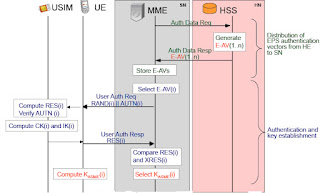Security
Mutual Authentication + Integrity+Ciphering
Control Plane :
1.UE - NAS and RRC
NAS -Control Plane between UE and MME
RRC- Integrity Protected and Ciphered between UE(RRC) and eNodeB
As discussed earlier their will be 6 steps involved in control plane security,lets see in detail
Step 1
Network tries to find out User context based on GUTI. If not found MME requests IMSI from UE
After receiving UE’s IMSI(Provided UE doesn’t have GUTI), the mobility management entity MME sends the home network HE /HSS AuC [Authentication Centre]Authentication Data Request which includes IMSI, serving networks SN identity and network type
Step 3
Upon receiving the request,
Step 4
What each entity does
Well in next post lets see Ciphering and Integrity along with Algorithms involved
Mutual Authentication + Integrity+Ciphering
Control Plane :
1.UE - NAS and RRC
NAS -Control Plane between UE and MME
RRC- Integrity Protected and Ciphered between UE(RRC) and eNodeB
As discussed earlier their will be 6 steps involved in control plane security,lets see in detail
Step 1
Network tries to find out User context based on GUTI. If not found MME requests IMSI from UE
Step 2
After receiving UE’s IMSI(Provided UE doesn’t have GUTI), the mobility management entity MME sends the home network HE /HSS AuC [Authentication Centre]Authentication Data Request which includes IMSI, serving networks SN identity and network type
Step 3
Upon receiving the request,
Step 4
HE generates an EPS authentication vector/(s) (RAND,XRES, AUTN,KSIASME)
where the first three parameters are same as those in the EAP-AKA, and
KSIASME is the key set identity of access security management entity ASME
Step 5: MME sends the RAND, AUTN and KSIASME to the UE which verifies the AUTN and authenticates the networks.
Step 6: If successful, UE generates the response RES and sends it back to MME which compares XRES with RES and authenticates UEWhat each entity does
Well in next post lets see Ciphering and Integrity along with Algorithms involved

